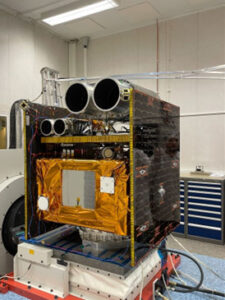A few years ago the camera technology constituted a core component of the Earth Observation satellite vendors competitivity that was never marketed outside. From Loral to Airbus, from OHB to Thales, the sensor was the …
A few years ago the camera technology constituted a core component of the Earth Observation satellite vendors competitivity that was never marketed outside. From Loral to Airbus, from OHB to Thales, the sensor was the heart of the mission, the most expensive and critical component around which, the satellite was designed and built, and the mission was characterized.
Apertures of a minimum of 500 mm defined single lenses and mirror prototypes which were very difficult to manufacture and align.
Final resolutions were in the end limited by the pixel size from the selected detectors, less precise than the optics.
The arrival of New Space since 2017 brought a first revolution to this activity; small cameras for small satellites, but still with fair and good resolutions. Clearly the quality limitation of this generation was in the optics.
But the market still talks about GSD (pixel size) instead of addressing GRD (ground resolution distance), the true measurement of the minimum distance between 2 separated objects.
The capturing process, based on TDI line sensors, with high illumination, demanded a high stability from the satellite, in order to avoid blurring. Therefore the satellites took minutes to get stabilized and barely could move outside of the orbit.
This first wave of cameras and missions for EO belong to the so called “ the demonstrators generation”. Not the client governments, nor the agencies or the vendors wanted to face the fact that the images produced were not actionable or useful. A substantial number of those launches do not have a user, a real customer behind, and rather they have been a technology push exercise that has satisfied the stakeholders for a while.
The arrival of a reality check from Defense customers, from private organizations like Oil& Gas and NGOs on climate action, has started to demand professional image features like flatness, signal to noise, MTF and a general calibrated picture.
Many times, the absence of baffles due to the lack of room in a cubesat produces high contamination of dispersed light. The lack of focal distance creates larger distortions outside of the image centre. The focal plane precision again erodes the image quality.
Several image vendors, very successful in the first wave, cannot provide satisfied customers and are lying behind. The trend for the survivors is larger cameras, larger apertures, larger F numbers, massive digital embedded processing capacities and multi sensor fusion.
But perhaps the most interesting topic is the DIGITAL transformation of image capture. A set of tens of images per second captured sequentially provides the resource to challenge the diffraction limit of light, to share the info between a fair number of spectral bands, to stress the resolution when the signal is large, to increase this signal and to improve the MTF.
This is how cameras of 170mm aperture can provide a native spectral resolution in 5 bads below 1 metre, for instance.
 Furthermore, the fact that these cameras are small, make them suitable for a combination of channels on the same platform, similar to the Worldview concept from Maxar, prpbably the best EO satellite in 2020. Today this combination can fit in a total mass of 100kg, and new features like polarimetry or video are also available in those platforms.
Furthermore, the fact that these cameras are small, make them suitable for a combination of channels on the same platform, similar to the Worldview concept from Maxar, prpbably the best EO satellite in 2020. Today this combination can fit in a total mass of 100kg, and new features like polarimetry or video are also available in those platforms.
The proficiency in computing electronics, based on 3rd generation FPGAs and GPUs defines the teams that are capable of implementing this revolution.
Software parallelization is also a critical task to equilibrate the challenges.
Sometime ago, a Space Camera producer was the highest engineering actor in terms of precision mechanics and optics. Today these professions must be by complemented by FPGA builders, software architects and algorithm developers, a totally new world that knows how to handle datacubes of 20 bands that must be merged and processed.
JUAN TOMAS HERNANI is cofounder and CEO of SATLANTIS, the largest space camera vendor for Microsats.




